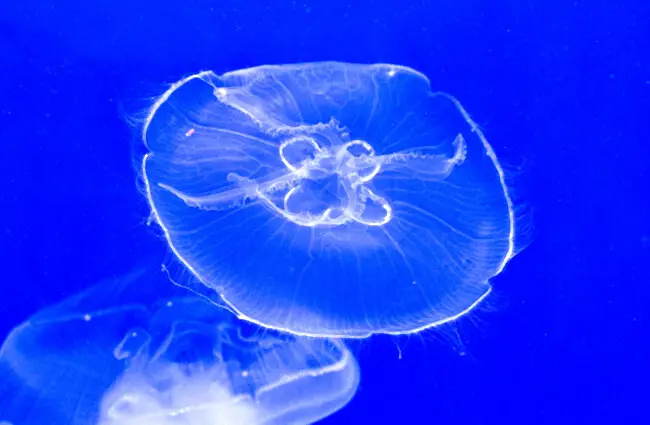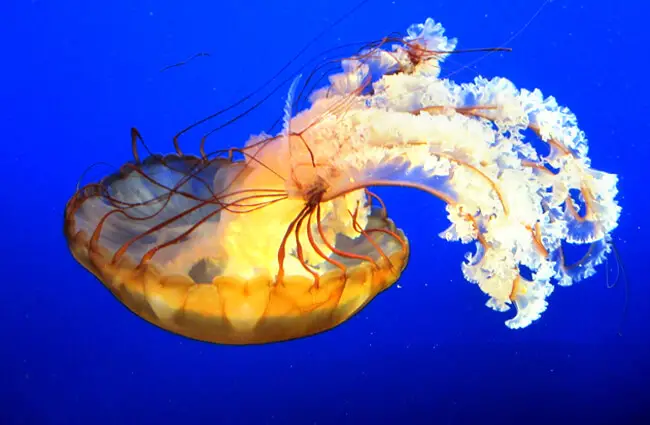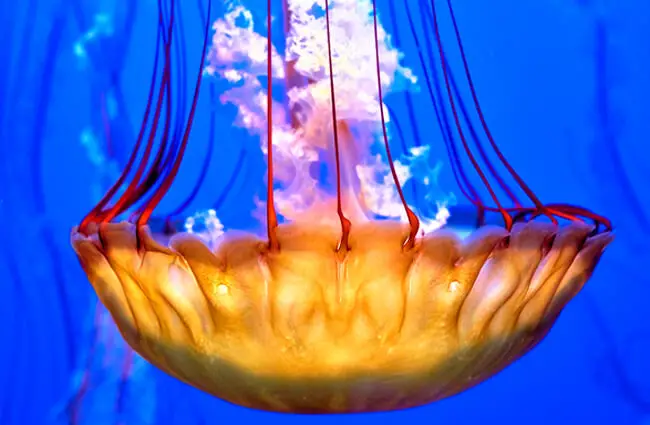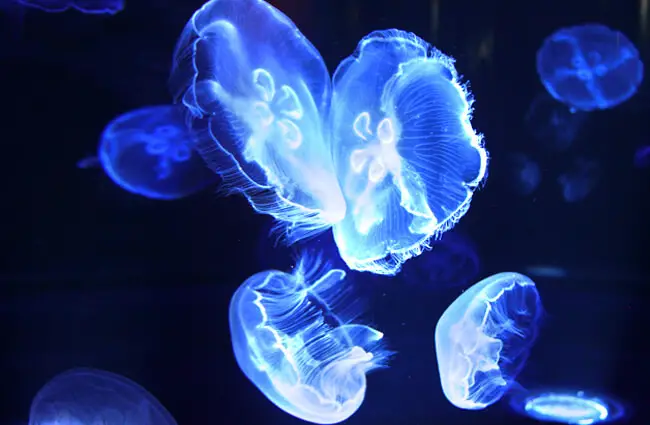People refer to a number of different invertebrate creatures as “Jellyfish.” However, researchers place the true Jellyfish in the taxonomic class Scyphozoa. They currently recognize about 200 species in 20 different families, but there may be as many as 400 different species in this group! Read on to learn about the Jellyfish.
Description of the Jellyfish
These creatures come in an immense variety of shapes and sizes. Generally, their bodies consist of a rounded bell with a mouth on the underside. Shorter tentacles and longer stinging arms generally grow from the bell.
Size varies drastically from species to species. Some measure less than an inch across, while others reach six feet in diameter or more!
Interesting Facts About the Jellyfish
The immense variety of species possess a number of different traits and adaptations. Learn more about what makes a few specific species unique, below.
- Lion’s Mane Jelly – This species is the largest in this group. The largest recorded specimen had a bell with a 7 ft. diameter, and its tentacles measured a whopping 112 ft. long!
- Upside-Down Jelly – As the name suggests, this species is one of several jellies that orients itself in an upside-down position. It sits with its bell against the ground and waves its tentacles upwards. Instead of a mouth on its bell, this species has many mouths on its tentacles.
- Moon Jelly – You can find this species throughout much of the world’s oceans. A wide variety of different sea creatures rely on this species for food, including sunfish, other Jellyfish, leatherback sea turtles, and more.
- Nomura’s Jelly – Another incredibly large species, this jelly shares a family with the lion’s mane jelly. Blooms of this species have steadily increased in the Sea of Japan over the past decade. These blooms have proven detrimental to local fish populations.
Habitat of the Jellyfish
The various species live in a wide range of different habitats. Some live in the deep sea, some in pelagic regions of the open ocean, and some occupy frigid arctic waters, but most live in coastal regions. However, all of the various species occupy marine, or saltwater habitats and some range into brackish waters. None of the species live in freshwater.
Distribution of the Jellyfish
These creatures have global distribution. You can find them in every ocean on Earth. Each species has its own unique range. Some species live across vast expanses and have cosmopolitan distribution. Other species live only in small regions. The populations of many species overlap with those of other species.
Diet of the Jellyfish
While their diet varies based on the species, all jellies have carnivorous feeding habits. Though a small number hunt using filter feeding and eat primarily plankton, the vast majority capture prey using their stinging arms and tentacles. They eat any small fish or crustacean that happens to drift into their stinging arms and become entangled.
Jellyfish and Human Interaction
Different species interact with humans in different fashions. People view many species as nuisances because of their painful stings. The stings of some species can even pose a danger to humans. People also commercially catch a few species as food sources.
The impact of human activity varies from species to species. Some species have booming populations while others dwindle because of human activity.
Domestication
Humans have not domesticated these creatures in any way.
Does the Jellyfish Make a Good Pet
No, you wouldn’t want a jelly as a pet. Many species grow quite large, and all have stinging cells on their arms and tentacles. Additionally, you couldn’t keep any other fish in your aquarium because they would sting them.
Jellyfish Care
Aquariums keep many different species in their collections. Though the care varies from species to species, for the most part they have similar needs. Aquarists generally keep a gentle flow of water in their rounded tanks to prevent the jellies from drifting into the glass and injuring themselves. Most facilities feed them small fish or shrimp.
Behavior of the Jellyfish
For the most part, these creatures do not have complicated behavior. They can use the muscles in their bells to propel themselves, but they generally drift wherever the current pushes them. Most species do not actively seek prey, but eat whatever happens into their tentacles.
Reproduction of the Jellyfish
These creatures generally reproduce by expelling their eggs and sperm from their mouths. Fertilized eggs hatch into a larval life form known as a “planula.” This larva attaches itself to the bottom and grows into a polyp. That polyp then buds off several miniature versions of the adult Jellyfish, known as “medusas.” The medusa grows and eventually repeats the cycle.



![These spectral creatures pulse along on ocean currents, squirting water from their mouths to propel them. Spectral jellyfish Photo by: Bernard Spragg. NZ [public domain] https://creativecommons.org/licenses/by-sa/2.0/](https://animals.net/wp-content/uploads/2020/01/Jellyfish-1-650x425.jpg)







![These spectral creatures pulse along on ocean currents, squirting water from their mouths to propel them. Spectral Jellyfish Photo By: Bernard Spragg. Nz [Public Domain] Https://Creativecommons.org/Licenses/By-Sa/2.0/](https://animals.net/wp-content/uploads/2020/01/Jellyfish-1-162x141.jpg)


















![Red Angus Closeup of a beautiful Red Angus cowPhoto by: U.S. Department of Agriculture [pubic domain]https://creativecommons.org/licenses/by/2.0/](https://animals.net/wp-content/uploads/2020/03/Red-Angus-4-100x75.jpg)

